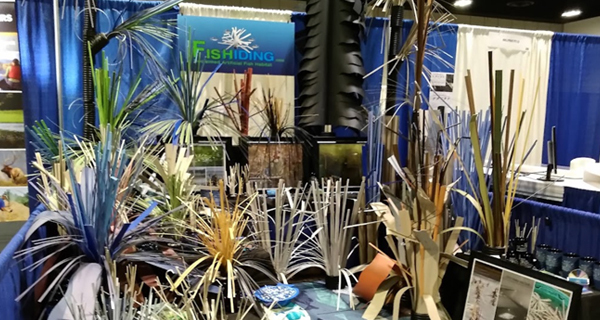Original Fishiding Habitat Musky Study
Posted by David Ewald on 27th Aug 2015
Wild Rose muskie-rearing study dependent on vinyl
BY LARRY POLENSKE CONTRIBUTING WRITER
Posted on September 5, 2013
Wild Rose, Wis. — A study to see if artificial structure placed in rearing ponds improves growth rates and hardiness of muskies is being conducted at the Wild Rose Fish Hatchery.
Pieces of “structure” made from scrap vinyl was bought for the Wild Rose rearing ponds by the Winnebagoland Musky Club, a matching grant from the Hugh C. Becker Foundation in Minnesota, and a donation from the family of the late Mike Primising, a former fish biologist in Waushara County.
Steve Fajfer, DNR hatchery supervisor at Wild Rose, said the idea for the study came about after renovations were made at the hatchery. The local soil is sandy and water drains quickly through it. New rearing ponds at Wild Rose had to be lined with plastic to hold water. The liners also made the ponds easier to clean, but the ponds resembled large swimming pools with a sterile, unnatural look.
“It’s great for efficiency of water and fertilization and harvest,” Fajfer said. “We can disinfect it. It’s a really great situation. But when we started putting muskies in the ponds we noticed that they seemed to be uncomfortable. Muskies like to have structure nearby. If you saw a bit of grass floating on the surface, muskies would gather around it. Then you would see muskies gathered around each other simply because it was something to sit next to.”
Fajfer reasoned that in a natural setting, muskies would have weeds, rocks, trees, or other cover to which to relate.
“We wondered if having some type of structures in the pond would be beneficial to muskie survival and growth,” he said.
Fajfer said a major concern about adding structure to the ponds was biosecurity. In the past, old Christmas trees or something similar would have been placed the ponds. These things eventually would decay and contribute to fungus and bacterial growth that is unacceptable in the small environment of a rearing pond.
A product made by Fishiding in Wonder Lake, Ill., looked like a solution to the biosecurity problem. Fishiding.com uses scrap vinyl to make artificial structure. A concrete core weights the piece, and vinyl strips attached to the base can be bent and angled to simulate weed growth that would be found in a natural aquatic environment. The structures can be removed for cleaning and sterilization.
Fajfer liked the Fishiding idea, but there was no money in his budget to make the purchase.
A short time later, he was contacted by the Winnebagoland Musky Club to see if the hatchery had any projects with which it could help. The timing was perfect, and the club agreed to fund the project, but it only had half the money needed to buy the vinyl.
Club member Jerry Loop said his group contacted the Hugh C. Becker Foundation in Minnetonka, Minn., for help. George Selcke, of the foundation, said Becker was one of the original members of Muskies, Inc., and he did some pioneering work on tagging muskies for research. Becker passed away in 2007, and one of the things his foundation does is help fund projects that improve muskie fishing.
The foundation approved a matching grant of $3,000 for the project. Fishiding agreed to provide the structure at cost to aid in the study. On Aug. 6, five people from Fishiding delivered the structure to Wild Rose. Hatchery personnel and volunteers from Winnebagoland Musky Club helped the Fishiding.com crew form and place the structures in two rearing ponds. Two other ponds will serve as controls.
Great Lakes spotted muskies will be the first batch of fish used in the study. The fingerlings hatched at Michigan DNR’s Wolf Lake Fish Hatchery will be divided among the four ponds. In about a year, the muskies will be stocked in Anderson and Archibald lakes in Oconto County and Elkhart Lake in Sheboygan County to serve as future brood stock, to collect eggs to return Great Lakes spotted muskies in Wisconsin waters. Fajfer said the only population of Great Lakes spotted muskies in the state at this time is in Green Bay, where the presence of VHS prevents the DNR from using those fish for brood stock.
The muskies will be fitted with passive integrated transponders (PIT tags), which are individually numbered, so researchers can record their growth and survival.
“The fish will all be measured and counted before they go in the rearing ponds,” Fajfer said. “We will do everything the same (in all four ponds) as much as we can with minnows, flows, and temperatures and monitor them over the next 11 months they are in the hatchery.”
When they are harvested for stocking, hatchery personnel can see if the muskies from the ponds with structure are larger than those in the barren ponds. Long term, the PIT tags will show how the muskies grow and survive in the lakes. It will be four to five years before that information is known.
The lakes where the muskies will be stocked all have a 50-inch size limit to protect the fish.
“Those lakes were chosen for several reasons,” said Mike Donofrio, DNR fisheries team supervisor. “They already had muskie populations so we knew muskies would survive and do well there. They had a good forage base so there was plenty of food for the muskies.”
Other factors considered were the size of the lakes, good access points, and areas where the muskies could be netted for egg harvest in the future.



